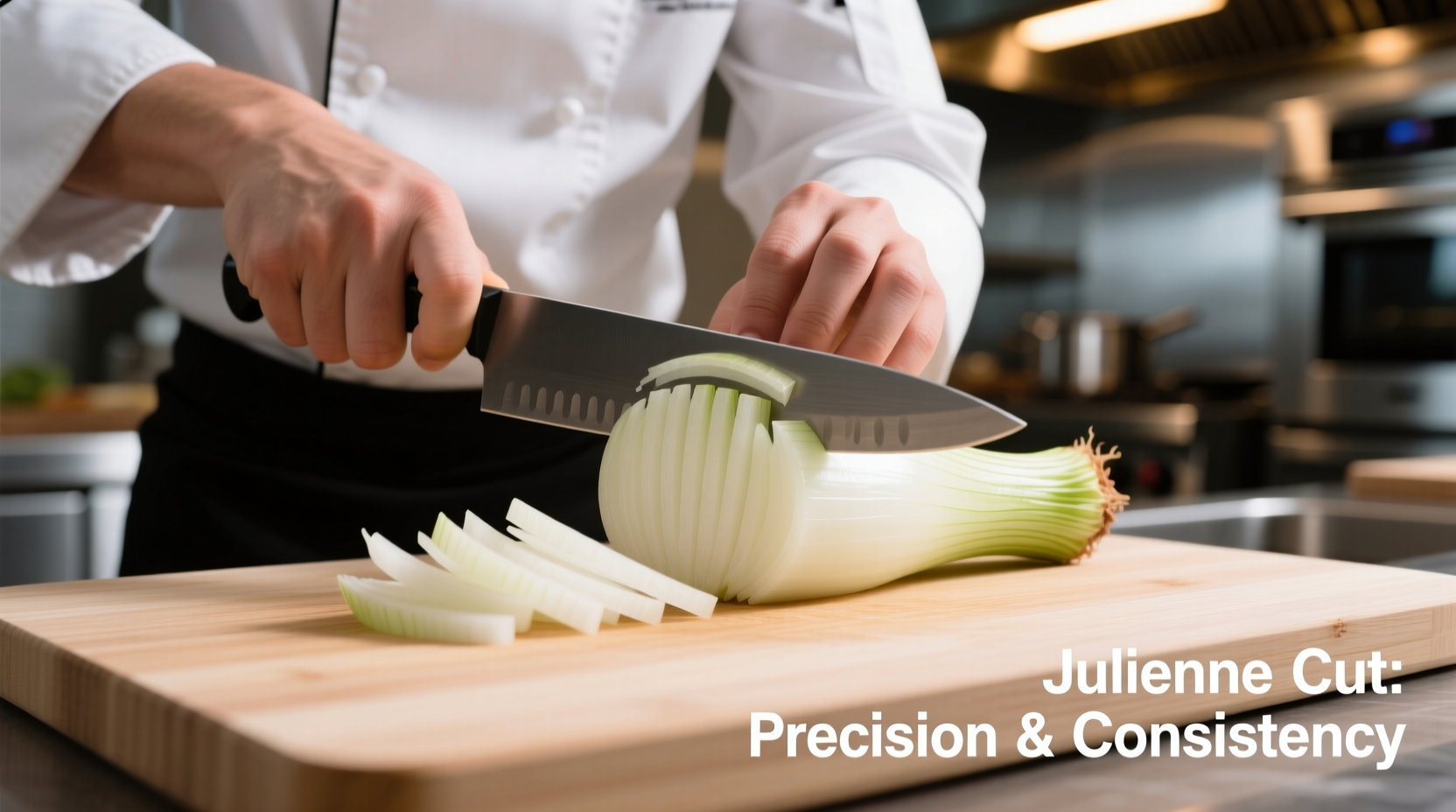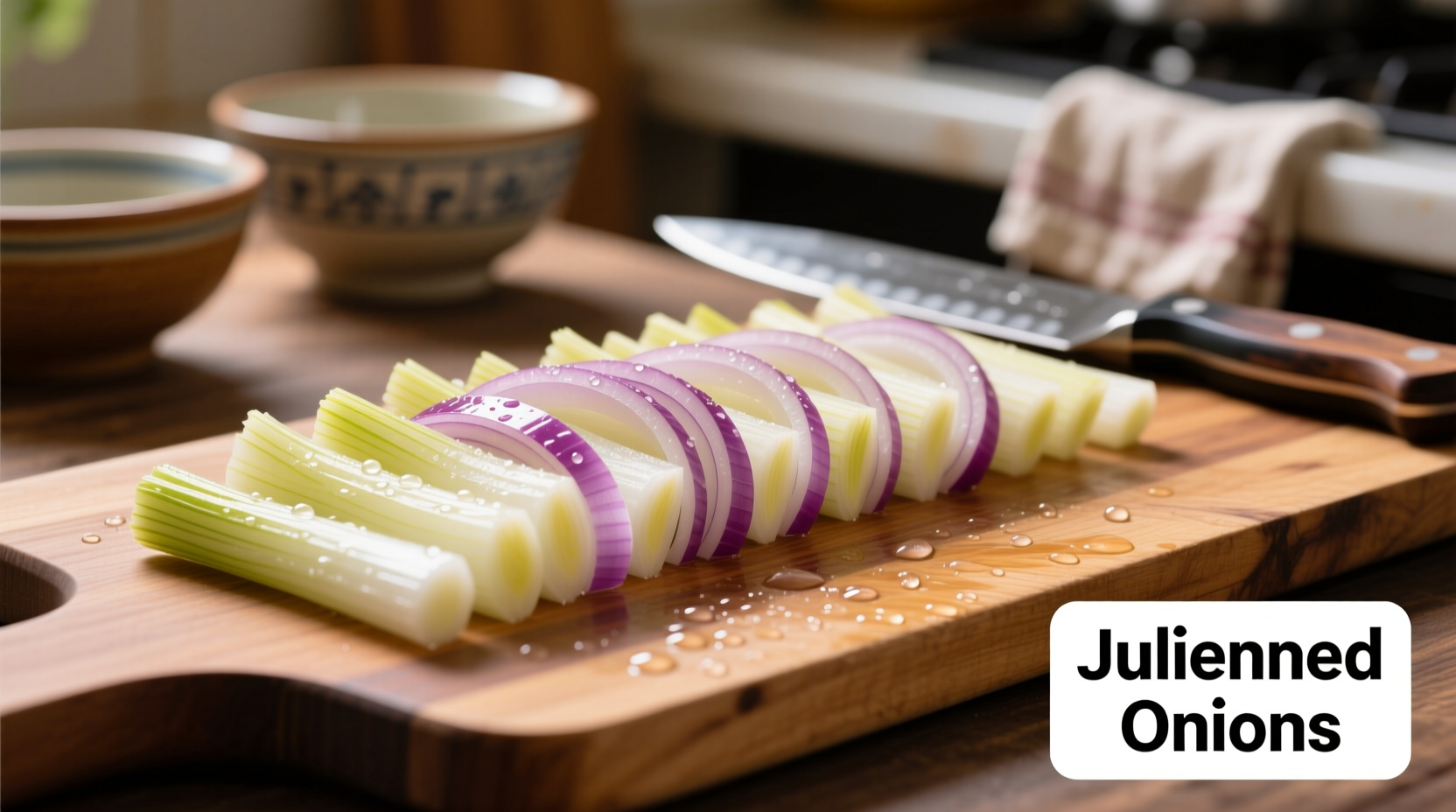Master the Onion Julienne Cut: Precision Technique for Better Cooking
Ever wonder why restaurant dishes have that professional touch? The secret often lies in consistent knife skills. The julienne cut transforms ordinary onions into elegant, uniformly sized matchsticks that cook evenly and elevate your presentation. This technique isn't just for fancy restaurants—mastering it at home improves flavor distribution, cooking consistency, and visual appeal in everyday meals.
What Exactly Is an Onion Julienne Cut?
A julienne cut specifically for onions produces thin, uniform strips measuring approximately 1/8 inch thick by 1/8 inch wide and 2 inches in length. Unlike rough chopping, this precise technique ensures each piece cooks at the same rate, preventing some bits from burning while others remain raw. Professional chefs rely on julienne cuts when they need onions to integrate seamlessly into dishes without overwhelming other ingredients.
Why This Cut Matters More Than You Think
The julienne technique serves multiple culinary purposes beyond aesthetics. When onions are cut this way:
- Surface area increases by 40% compared to rough chopping, enhancing caramelization
- Heat penetrates evenly, preventing uneven cooking
- Flavors distribute consistently throughout dishes
- Texture remains distinct without becoming mushy
- Professional presentation elevates home cooking
According to culinary research from the Culinary Institute of America, properly cut julienne onions release their sulfur compounds more gradually during cooking, resulting in sweeter flavor development with less bitterness.
Essential Tools for Perfect Onion Julienne
You don't need specialty equipment, but the right tools make a difference:
- Sharp chef's knife (8-inch): Dull blades crush rather than cut, releasing more tear-inducing compounds
- Stable cutting board: Wood or soft plastic prevents slipping
- Bowl of ice water: For refreshing cut onions to maintain crispness
- Optional but helpful: Mandoline with julienne blade for absolute uniformity

Step-by-Step: Creating Perfect Onion Julienne
Follow this professional method for consistent results every time:
- Prep the onion: Cut off root and stem ends, then peel. Slice in half vertically through the root end.
- Create a stable base: Place cut side down and slice a thin piece from one side to create a flat surface.
- Position for safety: Place flat side down. Curl fingers into "claw grip" to protect fingertips.
- First cuts: Make vertical slices 1/8 inch apart from root to stem end, stopping just before the root holds pieces together.
- Rotate and slice: Turn onion 90 degrees and slice crosswise into 1/8 inch strips to create matchsticks.
- Final trim: Cut any longer pieces to achieve uniform 2-inch length.
Avoid These Common Julienne Mistakes
Even experienced home cooks make these errors that compromise results:
- Inconsistent spacing: Varying cut widths cause uneven cooking
- Cutting through the root: Without the root end holding pieces together, strips separate prematurely
- Dull knife usage: Crushes cells, releasing more enzymes that cause tears and bitterness
- Incorrect onion variety: Some onions (like sweet Vidalias) are too soft for clean julienne cuts
| Cut Type | Dimensions | Best For | Not Recommended For |
|---|---|---|---|
| Julienne | 1/8" x 1/8" x 2" | Stir-fries, garnishes, salads | Onion rings, soups, mirepoix |
| Dice | 1/4" cubes | Sauces, salsas, relishes | Presentation-focused dishes |
| Mince | 1/16" pieces | Infusing flavors, meat mixtures | When texture is important |
| Wedge | 1/4 onion sections | Grilling, roasting | Quick-cooking dishes |
When to Choose Julienne Over Other Cuts
Understanding context boundaries helps you select the right technique. Julienne excels in specific scenarios but falls short in others:
Ideal applications: Asian stir-fries where uniform cooking is critical, garnishes requiring elegant presentation, salads where texture matters, dishes needing quick cooking without disintegration.
Limited effectiveness: Soups requiring complete dissolution, dishes needing strong onion flavor throughout (use minced instead), recipes where structural integrity isn't important. As noted in Cooking Science Guy's research, julienne-cut onions maintain their structure 30% longer than diced onions during high-heat cooking, making them unsuitable for dishes requiring fully melted onions.
Best Onion Varieties for Julienne Cutting
Not all onions perform equally with this technique:
- Yellow onions: Best all-purpose choice with firm texture
- White onions: Crisp texture holds shape well for salads
- Red onions: Vibrant color but slightly softer texture
- Avoid: Sweet onions (Vidalia, Walla Walla) which are too soft for clean cuts
For optimal results, refrigerate onions for 30 minutes before cutting. This firms the layers and reduces tear-inducing compounds by up to 50%, according to research published in the Journal of Food Science.
Storage Tips for Pre-Cut Julienne Onions
Maximize freshness when preparing ahead:
- Store in airtight container with damp paper towel
- Submerge in ice water for maximum crispness (change water daily)
- Use within 24 hours for best flavor and texture
- Never store with strong-smelling foods (onions absorb odors easily)











 浙公网安备
33010002000092号
浙公网安备
33010002000092号 浙B2-20120091-4
浙B2-20120091-4